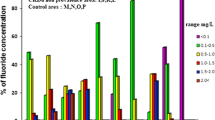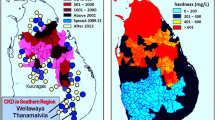Abstract
Contamination by metals and microbiological agents in hemodialysis water can cause clinical intercurrences in hemodialysis patients. Evaluating and assuring minimum levels of contamination from metals and microorganisms in hemodialysis water can improve patient safety. The objective of this study was to assess hemodialysis water quality in a major tertiary hospital in Brazil and investigate the relationship between hemodialysis water quality and clinical intercurrences in hemodialysis patients. A prospective-observational cohort study for evaluation of water quality parameters and clinical intercurrences present by patients (n = 52) were performed from May 2014 to April 2015. Mixed linear regression models and binary regression models were fitted for water quality parameters and patients’ clinical parameters. The increase in the levels of copper and nitrate in hemodialysis water was significant (p < 0.05) to explain anemia. Bone pain was related to age, sex (female), and hemodialysis treatment duration (years). Hypotensive episodes were related to serum sodium decrease. Aluminum in hemodialysis water was present in an average concentration higher than the permitted threshold (15.35 ± 14.53 μg/L). Cadmium, total coliforms, Escherichia coli, and endotoxins in hemodialysis water were not detected and the heterotrophic bacteria count was below the reference limit. These parameters’ concentrations varied during the study, evidencing the need for continuous monitoring.
Similar content being viewed by others
References
Wong J, Vilar E, Farrington K (2015) Haemodialysis. Medicine 43(8):478–483. https://doi.org/10.1016/j.mpmed.2015.05.010
Brasil (2014) Resolução RDC no. 11, de 13 de março de 2014. Dispõe sobre os Requisitos de Boas Práticas de Funcionamento para os Serviços de Diálise e dá outras providências. Brasília, DF, 14 de março de 2014
Association for the Advancement of Medical Instrumentation (2014) Water for haemodialysis and related therapies, AAMI/ISO 13959:2014. AAMI, Arlington
Buzzo ML, Bugno A, Almodovar AAB, Kira CS, Carvalho FH, Souza A, Scorsafava MA (2010) A importância de programas de monitoramento da qualidade da água para diálise na segurança dos pacientes. Rev Inst Adolfo Lutz 69(1):1–6
Layman-amato RL, Curtis J, Payne GM (2013) Water treatment for hemodialysis: an update. Nephrol Nurs J 40(5):383–404
Hoenich NA, Ronco C, Levin R (2006) The importance of water quality and haemodialysis fluid composition. Blood Purif 24:11–18. https://doi.org/10.1159/000089430
Hoenich NA, Ronco C (2007) Haemodialysis fluid: composition and clinical importance. Blood Purif 25:62–68. https://doi.org/10.1159/000096400
Fendley DA, Ward RA (2012) Dialysate quality: new standards require a new approach to compliance. Semin Dial 25(5):510–515. https://doi.org/10.1111/sdi.12007
Verma S, Indumathi VA, Gurudev KC, Naik SA (2015) Bacteriological quality of treated water and dialysate in haemodialysis unit of a tertiary care hospital. J Clin Diagn Res 9(10):DC14–DC16. https://doi.org/10.7860/JCDR/2015/14681.6692
Coulliette AD, Arduino MJ (2013) Hemodialysis and water quality. Semin Dial 26(4):427–438. https://doi.org/10.1111/sdi.12113
Kidney Disease Improving Global Outcomes (2012) Clinical practice guideline for anemia in chronic kidney disease. Kidney Int Suppl 2(4):279–335. https://doi.org/10.1038/kisup.2012.41
American Public Health Association (2012) Standard methods for the examination of water and wastewater, 22 st. ed. Washington DC: APHA-AWWA-WEF, 1360 p
Companhia de Tecnologia de Saneamento Ambiental (2009) Análises microbiológicas de amostras ambientais. CETESB, São Paulo 134p
Borges CR, Lascowski KM, Filho NR, Pelayo JS (2007) Microbiological quality of water and dialysate in a haemodialysis unit in Ponta Grossa-PR, Brazil. J Appl Microbiol 103(5):1791–1797. https://doi.org/10.1111/j.1365-2672.2007.03431.x
Bazán JL, Torres-Avilés F, Suzuki AK, Louzada F (2017) Power and reversal power links for binary regressions: Na application for motor insurance policyholders. Appl Stoch Model Bus Ind 33(1):22–34. https://doi.org/10.1002/asmb.2215
Iorio BD, Cirillo M, Bellizzi V, Stellato D, Santo NG (2007) Prevalence and correlates of anemia and uncontrolled anemia in chronic hemodialysis patients--the Campania Dialysis Registry. Int J Artif Organs 30(4):325–333
Morton AR, Singer MA (2007) The problem with Kt/V: dialysis dose should be normalized to metabolic rate not volume. Semin Dial 20:12–15. https://doi.org/10.1111/j.1525-139X.2007.00232.x
Adams SV, Rivara M, Streja E, Cheung AK, Arah OA, Kalantar-Zadeh K, Mehrotra R (2017) Sex differences in hospitalizations with maintenance hemodialysis. J Am Soc Nephrol 28(9):2721–2728. https://doi.org/10.1681/ASN.2016090986
Onufrak SJ, Bellasi A, Cardarelli F, Vaccarino V, Muntner P, Shaw LJ, Raggi P (2009) Investigation of gender heterogeneity in the associations of serum phosphorus with incident coronary artery disease and all-cause mortality. Am J Epidemiol 169(1):67–77. https://doi.org/10.1093/aje/kwn285
Cobo G, Hecking M, Port FK, Exner I, Lindholm B, Stenvinkel P, Carrero JJ (2016) Sex and gender differences in chronic kidney disease: progression to end-stage renal disease and haemodialysis. Clin Sci 130(14):1147–1163
Ellam T, Fotheringham J, Kawar B (2014) Differential scaling of glomerular filtration rate and ingested metabolic burden: implications for gender differences in chronic kidney disease outcomes. Nephrol Dial Transplant 29:1186–1194. https://doi.org/10.1093/ndt/gft466
Abensur H (2004) Anemia da doença renal crônica. J Bras Nefrol 21(3):26–18
Junglee NA, Rahman SU, Wild M, Hirst S, Jibani M, Seale JRC (2010) When pure is not so pure: chloramines-related hemolytic anemia in home hemodialysis patients. Hemodial Int 14(3):327–332. https://doi.org/10.1111/j.1542-4758.2010.00454.x
Damasiewicz MJ, Polkinghorne KR, Kerr PG (2012) Water quality in conventional and home hemodialysis. Nat Rev Nephrol 8(12):725–734. https://doi.org/10.1038/nrneph.2012.241
Manzler AD, Schreiner AW (1970) Copper-induced acute hemolytic anemia: a new complication of hemodialysis. Ann Intern Med 73:409–412
Powlson DS, Addiscott TM, Benjamin N, Cassman KG, de Kok TM, van Grinsven H, L'Hirondel JL, Avery AA, van Kessel C (2008) When does nitrate become a risk for humans? J Environ Qual 37(2):291–295. https://doi.org/10.2134/jeq2007.0177
Abu Naser AA, Ghbn N, Khoudary R (2007) Relation of nitrate contamination of groundwater with methaemoglobin level among infants in Gaza. East Mediterr Health J 13(5):994–1004
Ziebarth A (1991) Well water, nitrates and the blue baby syndrome methemoglobinemia. University of Nebraska, Lincoln, Nebraska
Fouad M, Boraie M (2015) The impact of chronic kidney disease – mineral and boné disorder on the locomotor system and quality of life in hemodialysis patients. Turk Neph Dial Transpl 24(3):294–301. https://doi.org/10.5262/tndt.2015.1003.08
Dahl C, Sogaard AJ, Tell GS, Flaten TP, Hongve D, Omsland TK, Meyer HE, Aamodth G (2014) Do cadmium, lead, and aluminum in drinking water increase the risk of hip fractures? A NOREPOS study. Biol Trace Elem Res 157(1):14–23. https://doi.org/10.1007/s12011-013-9862-x
Agency for Toxic Substances and Disease Registry (2008) Toxicological Profile for Aluminum. ATSDR, U.S. Department of Health and Human Services, Public Health Services, Atlanta, GA 357p
Bonadio SL, Paschoalato CFPR, Júnior RP, Innocentini MDM (2005) Avaliação da qualidade da água do rio Pardo na região de Ribeirão Preto. http://www.bvsde.paho.org/bvsaidis/uruguay30/BR08505_Bonadio.pdf
Exley C (2013) Human exposure to aluminium. Environ Sci Processes Impacts 15:1807–1816. https://doi.org/10.1039/c3em00374d
Sjögren B, Iregren A, Elinder CG, Yokel RA (2007) Aluminium, chapter 17. In: Nordberg GF, Fowler BA, Nordberg M, Friberg L (eds) Handbook on the toxicology of metals, 3° edição edn. Elservier Inc., New York City
Daugirdas JT, Blake PG, Ing TS (2013) Manual de diálise. 4° edição, Rio de Janeiro: Editora Guanabara Koogan, 744p
Golper TA, Fissel R, Fissel WH, Hartle M, Sanders ML, Schulman G (2014) Hemodialysis: core curriculum 2014. Am J Kidney Dis 63(1):153–163. https://doi.org/10.1053/j.ajkd.2013.07.028
Davenport A (2015) Complications of hemodialysis treatments due to dialysate contamination and composition errors. Hemodial Int 19:30–33. https://doi.org/10.1111/hdi.12350
Funding
This study was supported by the Coordination for the Improvement of Higher Education Personnel (CAPES).
Author information
Authors and Affiliations
Corresponding author
Ethics declarations
Conflict of Interest
The authors declare that they have no conflict of interest.
Ethical Approval
All procedures performed in studies involving human participants were in compliance with the ethical standards of the institutional and/or national research committee and with the 1964 Helsinki declaration and its later amendments or comparable ethical standards. The study was approved by the ethics committee of the University of São Paulo at Ribeirão Preto College of Nursing (report no. 343.500).
Rights and permissions
About this article
Cite this article
Suzuki, M.N., Fregonesi, B.M., Machado, C.S. et al. Hemodialysis Water Parameters as Predisposing Factors for Anemia in Patients in Dialytic Treatment: Application of Mixed Regression Models. Biol Trace Elem Res 190, 30–37 (2019). https://doi.org/10.1007/s12011-018-1515-7
Received:
Accepted:
Published:
Issue Date:
DOI: https://doi.org/10.1007/s12011-018-1515-7




